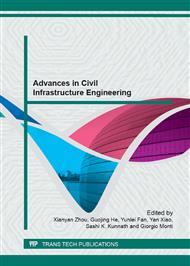p.752
p.757
p.765
p.770
p.774
p.778
p.782
p.786
p.790
Studies on Mechanical Properties of Diamond Bird-Beak XX-Joint
Abstract:
The diamond bird-beak XX-joint is a novel configuration for tubular structures and there are few correlated papers for it. Non-linear FE analyses are carried out on axially loaded XX-joints in order to study the mechanical properties of this type of joint. The individual influence of the following geometric parameters on the joint capacity, brace to chord width ratio β, chord width to wall thickness ratio 2γ, and brace to chord thickness ratio τ is made clear. Increasing either β or τ will increase the joint capacity and increasing 2γ will decreases joint capacity. The out-of-plane braces tension always decreases the ultimate capacity of joint and the equal tension and compression in the chord member have the same influence on the joint capacity. A reduction equation is proposed to consider the load effect of chord and out-of-plane braces axial forces.
Info:
Periodical:
Pages:
774-777
Citation:
Online since:
January 2013
Authors:
Price:
Сopyright:
© 2013 Trans Tech Publications Ltd. All Rights Reserved
Share:
Citation:


